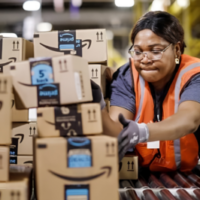Key Findings
An analysis of the latest available data self-reported by Amazon to the Occupational Safety and Health Administration shows:
- Amazon warehouse workers’ injuries increased by 20 percent in Connecticut from 2020 to 2021. The injury rate for workers employed at Amazon’s warehousing and logistics facilities in Connecticut increased by 20 percent from 2020 to 2021. The rate of worker injuries rose from 5.3 per 100 full time employees (FTEs) in 2020 to 6.3 per 100 FTEs in 2021.[1] The rise in Connecticut Amazon worker injury rates corresponds with a national rise in Amazon worker injuries after the company reinstituted its productivity tracking and disciplinary policies in the fall of 2020 following a suspension of those policies at the start of the pandemic.[2]
- Overwhelming majority of injuries to Connecticut Amazon workers were of the most serious kind. Ninety-three percent of injuries that Connecticut Amazon workers experienced were cases severe enough that workers could not continue performing their normal job duties and had to either change job duties or take time off work to recover.
- The injury rate at Connecticut Amazon facilities is 15 percent higher than the national warehousing industry average. In 2021, the total injury rate at Amazon warehousing and logistics facilities in Connecticut (6.3 per 100 FTEs) is 15 percent higher than the national average for warehousing and storage (5.5 per 100 FTEs).[3]
[1] Unless otherwise noted, all Connecticut injury rates reported in this brief are based on an analysis of the Occupational Safety and Health Administration (OSHA) Injury Tracking Application data, for the years 2020 and 2021, available at https://www.osha.gov/Establishment-Specific-Injury-and-Illness-Data. These data are self-reported by companies to OSHA. Companies are required to report any work-related injuries that require medical attention, and whether the injury caused workers to miss days of work or require a job transfer.
[2] CNBC (October 2020). “Amazon has resumed policies that penalize workers for taking too many breaks, just in time for Prime Day.” https://www.cnbc.com/2020/10/14/amazon-resumes-policy-that-dings-workers-for-taking-too-many-breaks.html and The Strategic Organizing Center (April 2022). “The Injury Machine: How Amazon’s Production System Hurts Workers.” https://thesoc.org/wp-content/uploads/2022/04/The-Injury-Machine_How-Amazons-Production-System-Hurts-Workers.pdf
[3] Occupational Safety and Health Administration (OSHA) Injury Tracking Application data, 2021 and U.S. Bureau of Labor Statistics, Survey of Occupational Injury and Illness, 2021



